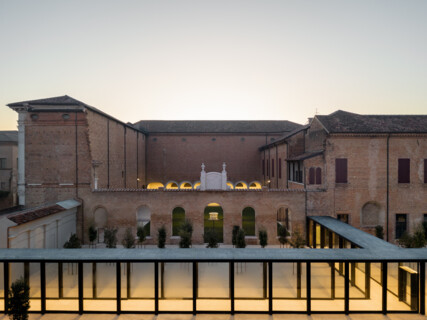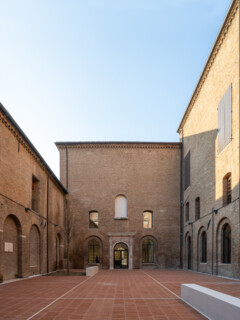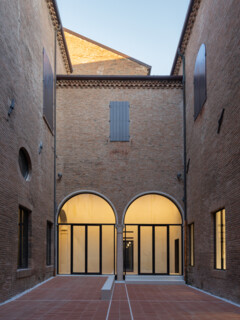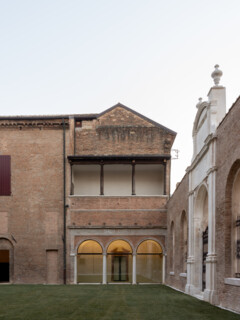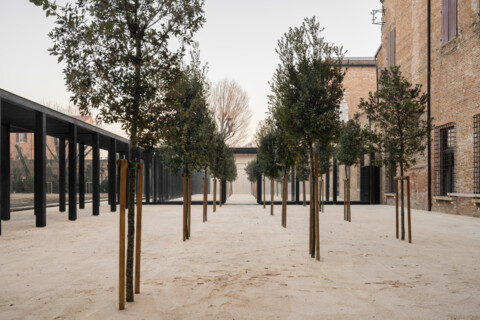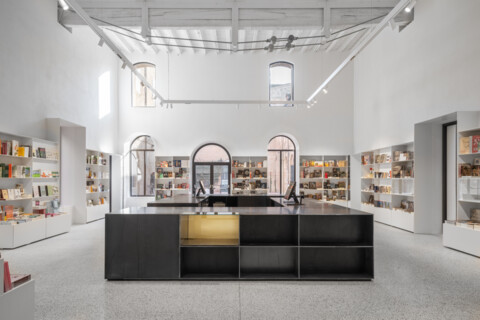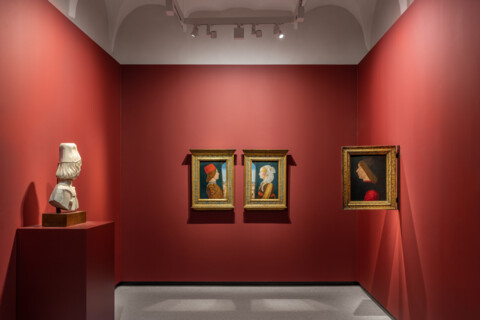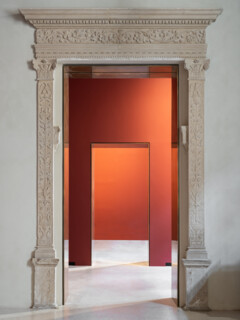Press release by CULTIVAR
17 February 2023
The Palazzo dei Diamanti, a Renaissance masterpiece and iconic building in Ferrara, Italy, reopens to the public after the careful restoration and refurbishment carried out by the architectural firm Labics (Maria Claudia Clemente and Francesco Isidori).
• Palazzo dei Diamanti is seen by Labics as a wonderful palimpsest — the product of multiple interventions and adaptations throughout the ages, additions and parts that were never completed — which today emerges clearly thanks to a project that holds all spaces together while exhibiting nothing other than its ability to give the museum a clear structure it never had.
The monumental complex of Palazzo dei Diamanti finds new life with the project of the exhibition space by Labics, returning to the city of Ferrara and Italy an invaluable cultural heritage. Labics' intervention is one of the rare contemporary projects carried out in recent times in Italy on a building of such high historical value.
• The architectural intervention by Labics (Maria Claudia Clemente and Francesco Isidori) is conceived as a museographic rewriting that enhances the configuration of the Renaissance palace itself, establishing a consequentiality and circularity between its rooms. The exhibition project links the two wings of the Palace and is completed with the wooden walkway that extends circulation into the garden, structuring the landscaping project by Stefano Olivari.
• Palazzo dei Diamanti is seen by Labics as a wonderful palimpsest — the product of multiple interventions and adaptations throughout the ages, additions and parts that were never completed — which today emerges clearly thanks to a project that holds all spaces together while exhibiting nothing other than its ability to give the museum a clear structure it never had.
Palazzo dei Diamanti in Ferrara, Italy reopens to the public after the careful restoration and refurbishment of the 16th-century complex and the renovation of exhibition spaces carried out by architectural firm Labics (Maria Claudia Clemente and Francesco Isidori.
The exhibition "Renaissance in Ferrara: Ercole de' Roberti and Lorenzo Costa” — curated by Vittorio Sgarbi and Michele Danieli on two great Ferrarese Renaissance masters and enriched by numerous international loans — provides the opportunity to admire the palace in all its richness and complexity, at the end of the works that involved it since the autumn of 2020. The exhibition will be open from February 18th to June 19th, 2023.
Palazzo dei Diamanti.
Designed by Biagio Rossetti, Palazzo dei Diamanti was built starting in 1493 and constitutes the ideal center of the so-called 'Addizione Erculea', an ambitious urban project conceived by Rossetti himself for Duke Ercole I d'Este that envisaged a doubling of the city of Ferrara. A symbol of Renaissance architecture and one of the most famous Italian monuments in the world, the palace is so-called because it exhibits 8,500 pyramid-shaped ashlars on its two external facades, alluding to the Este emblem of the diamond.
In February 2017, the Municipality of Ferrara launched an international two-phase competition for the renovation of Palazzo dei Diamanti in Ferrara, concerning the entire ground floor traditionally dedicated to high-profile temporary exhibitions. The group formed by Labics and 3TI progetti italia was selected from among 70 participating groups. After an initial interruption of the process by the Ministry of Cultural Heritage in 2019, the project was refined and approved.
The project by Labics.
The project by Labics, dedicated to the restoration and refurbishment of the complex as well as the renovation of its interior and exterior spaces for exhibition purposes, is encapsulated in an organic and integrated series of interventions that were started in October 2020 and completed in February 2023.
The first intervention involved the main pre-existing exhibition spaces: the Rossetti Wing and the Tisi Wing. The rooms were equipped with hightech surfaces, behind which all mechanical equipment is hidden. In the Rossetti Wing, new Venetian terrazzo floors were installed. New burnished brass portals were inserted in both wings to accentuate the spatial sequence of the Renaissance palace.
The second intervention involved the spaces formerly occupied by the Museum of the Risorgimento, which were completely renovated and designated for new functions to support the exhibition activities: coffee-shop, bookstore, educational room and multipurpose space. In addition, Labics renovated the courtyards within this section of the complex and reimagined them as "open-air rooms," integrating them into the museum’s itinerary and thus highlighting the distinctive features of a building that alternates solids and voids, indoor spaces and enclosed outdoor areas.
The third intervention focused on ensuring continuity in both indoor and outdoor paths. Regarding the internal pathways, Labics reopened a significant connection that had been interrupted over time between the former Museum of the Risorgimento and the main courtyard. Additionally, they improved access through the small loggia that faces the main courtyard, making it an essential part of the visitor's route.
The most significant intervention is the creation in the garden of a connection between the two wings of the Palace through a wooden structure, essential and light, partially glazed, which extends into the garden, highlighting its main geometries. The garden, conceived by Labics with landscape designer Stefano Olivari, recovers the layout of the ancient “brolo” (orchard) with its squares and rectangles and brings to light, in a contemporary key, the arrangement documented since the second half of the 18th century.
The contemporary museum.
The project by Labics arises from the awareness that architecture is a living art for which utilitas is a fundamental aspect. The interventions carried out for the Palazzo dei Diamanti constitute a cohesive set of actions aimed at both preserving the historic building, its spatiality, its intrinsic quality, and adapting its spaces to the needs of a modern exhibition venue. The project structures the paths of the monumental complex and establishes a contemporary idea of the museum space in the Palazzo dei Diamanti.
Labics.
The project of the exhibition space
Foreword
The project for the Palazzo dei Diamanti consists of an organic series of interventions aimed at restoring and enhancing the 16th-century complex and adapting both the interior and exterior spaces for exhibition purposes.
The project is driven by the belief that architecture, unlike painting, sculpture, or other art forms, is a living art that cannot only be contemplated for its beauty, but an art that to continue to exist must be experienced and, if necessary, reinterpreted. This has always been the case throughout the history of architecture, except for the tendency that, in recent times, has often seen the logic of pure conservation prevail over the possibility of rewriting and enriching the monuments that have been passed down to us from the past.
Even the Palazzo dei Diamanti, a masterpiece of the Italian Renaissance designed by Biagio Rossetti in 1492, has had a complex history over the centuries that makes it a wonderful palimpsest, made up of reconsiderations, subsequent additions, and unfinished parts. A building that, except for the external facades, lacks a comprehensive unity, as also evidenced by its current articulated use: the main floor, which includes the grand hall and the 16th-century apartment of Virginia de' Medici, houses the National Picture Gallery of Ferrara, while since 1991 the ground floor has been used as a venue for temporary exhibitions by the Ferrara Art Foundation. Palazzo dei Diamanti is therefore not a monument in itself, but an architecture destined to host public activities that consolidate its role and presence in the culture of our country; it is a testimony not only to the enormous heritage that has been passed down to us from the past, but also an opportunity to continue producing and conveying culture in the future.
Within this context, the interventions described below should be understood as an organic complex of actions aimed both at preserving the historic building, its spatiality, its intrinsic quality, and at adapting its spaces to the needs of a modern exhibition space.
Restoration and preliminary works
After analyzing and studying the ancient documents to distinguish the original parts from the later additions, the first task was to verify the state of conservation of the existing building envelope.
The project involved removing the old plasterboard linings, which were installed in the past to protect the original walls. Once removed, it was clear that the state of conservation was rather fragile: some walls had numerous and wide gaps resulting from the presence of old air conditioning systems; others had widespread damage resulting partly from the age of the building and partly from the presence of old unrepaired perforations. It was therefore necessary to initially proceed with a work of reconstruction of the flaws and consolidation of the damage before proceeding with the remaining work. The conservation status of the building required numerous "stitching and unstitching" interventions, injections of mortar, and repairs in order to restore the wall continuity and ensure a more general restoration.
Along with these restoration and consolidation works on the walls, a modern floor was removed - in the portion of the building that used to house the Risorgimento Museum - corresponding to the new bookshop, with the aim of restoring the original double-height space of the room. To this end, significant consolidation work was performed on the original wooden beam.
Finally, during the works, constantly supervised by the Archaeology, Fine Arts and Landscape Superintendence, a 15th-century "Este sauna" was found, restored and brought to light.
The design of the exhibition spaces
Once the restoration work was completed, the exhibition path was created, mainly in the areas previously designated for exhibition, namely the Rossetti Wing and the Tisi Wing.
All the rooms have been equipped with new highly technological and resistant surfaces, behind which equipment has been concealed. The new surfaces, which cover the ancient walls without altering their texture, hide the most advanced systems designed to ensure the thermo-hygrometric performance required for a contemporary art museum. In the Rossetti Wing, new Venetian terrazzo floors were installed. New burnished brass portals were inserted in both wings to accentuate the spatial sequence of the Renaissance palace.
The second intervention involved the spaces of the former Risorgimento Museum, completely restored, where new functions have been allocated to support the exhibition activity: coffee shop, bookshop, educational room and multipurpose space. In addition, the internal courtyards were renovated, equipped with new terracotta paving: conceived as real outdoor rooms, they have become an integral part of the museum itinerary, thus enhancing the peculiarity of the Palace which alternates between solids and voids, indoor spaces and enclosed outdoor areas.
The design of the pathways
The third intervention concerned the continuity of pathways – a central theme for an exhibition space – both inside and outside.
Regarding the internal pathways, a significant connection was reopened that had been interrupted over time between the former Museum of the Risorgimento and the main court. Additionally, access through the small loggia that faces the main court was improved, making it an essential part of the visitor's route.
The most significant intervention is the creation in the garden of a connection between the two wings of the Palace. As is well known, the main body of the building has an open-plan development, featuring a main courtyard adjacent to the access portico, which overlooks directly onto the rear garden (originally the "brolo"), filtered only by a two-dimensional partition that serves as a perspective backdrop.
The new project to connect the two wings, which was already envisioned in Andrea Bolzoni's 18th-century prints (1782), consists of a lightweight, trilithic wooden structure – partially glazed – which extends into the garden, highlighting its main geometries.
Consistent with the spatial structure of the Palace, characterized by an alternation of solids and voids, the new intervention defines new outdoor rooms in the garden that extend its logic, amplifying the sequence.
Its position in relation to the wall that defines the main court, axial and distanced from it, in fact, confirms the intention to leave an empty space, a sort of buffer zone, thereby reaffirming its role as a filter between two external spaces, a condition that it has maintained until the present day.
The structure, made of charred wood, is able to ensure good durability over time and low maintenance; the sliding glass panels, which protect the walkway during less favorable seasons, allow for a complete opening in order to restore the physical continuity between the Renaissance courtyard and the rear garden. The new structure, in fact, not only connects the two wings of the palace but, precisely because of its ephemeral nature, belongs to the garden, which has also been completely redeveloped.
The project of the garden
The project of the garden aims to reveal the arrangement of the ancient "brolo," which was divided into squares and rectangles as attested by Bolzoni's prints (1782) and attested by the 1843 survey.
The proposed intervention can therefore be considered as a new project on a historic site: in fact, it is neither a conservation of an existing garden, nor a pure restoration of a precise historical situation. The pre-existing trees, arranged in the "English style", have been preserved and intersect with the orthogonal layouts of the ancient “brolo”. This aesthetic coexistence of two opposing natures, regular and irregular, reveals the stratigraphy of different historical periods.
Two new elements complete the garden: the quincunx (an agricultural prescription handed down to us by Roman treatises to ensure rational cultivation with staggered rows) of holm oaks that creates a filter between the garden and the palace, and the body of water, a simple circular basin, that reflects the sky and invites the visitor to the far end of the garden.
Data and credits of the project
Name of the project
Completion of renovation, restoration and refurbishment of Palazzo dei Diamanti
Client
Municipality of Ferrara
Architect from the Municipal Office in charge of the process
Natascia Frasson
Architectural Project and Site Construction Management
Maria Claudia Clemente and Francesco Isidori
Structural and mechanical engineering
3TI progetti italia
Project of the restoration works
Elisabetta Fabbri
Project of the set-up works
Giovanni de Vito
Landscape design
Stefano Olivari
Garden light design
Massimiliano Baldieri
Schedule
Design competition / announcement: 28 February 2017
Design competition / awarding: 23 February 2018
Delivery of executive project, Lot A: September 2019
Delivery of executive project, Lot B: December 2020
Start of construction, Lot A: 21 October 2020
Start of construction, Lot B: 15 December 2021
Completion, Lot A: 27 December 2022
Completion, Lot B: 31 January 2023
Companies and Suppliers
Lot A: Palazzo dei Diamanti
BUOZZI (construction company)
iMartini (equipment)
VISUAL (furniture)
Techologica (steel window and door frames)
Lot B: walkway and garden
Mornico legnami (group leader)
Techologica (walkway window frames)
Arcadia (garden)
Dimensional data
Exhibition spaces: 790 square meters
(Rossetti Wing, Tisi Wing, Sauna del Duca and loggetta)
Exterior areas: 1.705 square meters
Serving spaces: 693,70 square meters
(bookshop, corridor, coffee shop, restrooms, educational room and multipurpose space, storage)
Walkway: 242,50 square meters
Exterior: 120 square meters
Interior: 122,50 square meters
Garden: 5.150 square meters
Exterior technical spaces: 517,50 square meters
Costs
Total 5.875.000 Euros
Including technical expenses of which:
- Lot A: Palazzo dei Diamanti
total financed amounting to 4.575.000 Euros
- Lot B: walkway and garden:
total financed amounting to 1.000.000 Euros
- Completion works:
total financed amounting to 300.000 Euros
Photographer
Marco Cappelletti
Press office
Cultivar
-
Renovation, restoration and refurbishment of Palazzo dei Diamanti, Ferrara | Labics (Maria Claudia Clemente and Francesco Isidori) | Photo: © Marco Cappelletti, Courtesy of Labics
-
Renovation, restoration and refurbishment of Palazzo dei Diamanti, Ferrara | Labics (Maria Claudia Clemente and Francesco Isidori) | Photo: © Marco Cappelletti, Courtesy of Labics
-
Renovation, restoration and refurbishment of Palazzo dei Diamanti, Ferrara | Labics (Maria Claudia Clemente and Francesco Isidori) | Photo: © Marco Cappelletti, Courtesy of Labics
-
Renovation, restoration and refurbishment of Palazzo dei Diamanti, Ferrara | Labics (Maria Claudia Clemente and Francesco Isidori) | Photo: © Marco Cappelletti, Courtesy of Labics
-
Renovation, restoration and refurbishment of Palazzo dei Diamanti, Ferrara | Labics (Maria Claudia Clemente and Francesco Isidori) | Photo: © Marco Cappelletti, Courtesy of Labics
-
Renovation, restoration and refurbishment of Palazzo dei Diamanti, Ferrara | Labics (Maria Claudia Clemente and Francesco Isidori) | Photo: © Marco Cappelletti, Courtesy of Labics
-
Renovation, restoration and refurbishment of Palazzo dei Diamanti, Ferrara | Labics (Maria Claudia Clemente and Francesco Isidori) | Photo: © Marco Cappelletti, Courtesy of Labics
-
Renovation, restoration and refurbishment of Palazzo dei Diamanti, Ferrara | Labics (Maria Claudia Clemente and Francesco Isidori) | Photo: © Marco Cappelletti, Courtesy of Labics
-
Renovation, restoration and refurbishment of Palazzo dei Diamanti, Ferrara | Labics (Maria Claudia Clemente and Francesco Isidori) | Photo: © Marco Cappelletti, Courtesy of Labics
-
Renovation, restoration and refurbishment of Palazzo dei Diamanti, Ferrara | Labics (Maria Claudia Clemente and Francesco Isidori) | Photo: © Marco Cappelletti, Courtesy of Labics
-
Renovation, restoration and refurbishment of Palazzo dei Diamanti, Ferrara | Labics (Maria Claudia Clemente and Francesco Isidori) | Photo: © Marco Cappelletti, Courtesy of Labics
-
Renovation, restoration and refurbishment of Palazzo dei Diamanti, Ferrara | Labics (Maria Claudia Clemente and Francesco Isidori) | Photo: © Marco Cappelletti, Courtesy of Labics
-
Renovation, restoration and refurbishment of Palazzo dei Diamanti, Ferrara | Labics (Maria Claudia Clemente and Francesco Isidori) | Photo: © Marco Cappelletti, Courtesy of Labics
-
Renovation, restoration and refurbishment of Palazzo dei Diamanti, Ferrara | Labics (Maria Claudia Clemente and Francesco Isidori) | Photo: © Marco Cappelletti, Courtesy of Labics
-
Renovation, restoration and refurbishment of Palazzo dei Diamanti, Ferrara | Labics (Maria Claudia Clemente and Francesco Isidori) | Photo: © Marco Cappelletti, Courtesy of Labics
-
Renovation, restoration and refurbishment of Palazzo dei Diamanti, Ferrara | Labics (Maria Claudia Clemente and Francesco Isidori) | Photo: © Marco Cappelletti, Courtesy of Labics
-
Renovation, restoration and refurbishment of Palazzo dei Diamanti, Ferrara | Labics (Maria Claudia Clemente and Francesco Isidori) | Photo: © Marco Cappelletti, Courtesy of Labics
-
Renovation, restoration and refurbishment of Palazzo dei Diamanti, Ferrara | Labics (Maria Claudia Clemente and Francesco Isidori) | Photo: © Marco Cappelletti, Courtesy of Labics
-
Renovation, restoration and refurbishment of Palazzo dei Diamanti, Ferrara | Labics (Maria Claudia Clemente and Francesco Isidori) | Photo: © Marco Cappelletti, Courtesy of Labics
-
Renovation, restoration and refurbishment of Palazzo dei Diamanti, Ferrara | Labics (Maria Claudia Clemente and Francesco Isidori) | Photo: © Marco Cappelletti, Courtesy of Labics
-
Renovation, restoration and refurbishment of Palazzo dei Diamanti, Ferrara | Labics (Maria Claudia Clemente and Francesco Isidori) | Photo: © Marco Cappelletti, Courtesy of Labics
